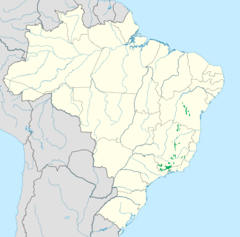Campos rupestres
| Campos rupestres | |
|---|---|
|
Campos rupestres in Serra do Espinhaço, Brazil. | |
 | |
| Ecology | |
| Biome | Tropical and subtropical grasslands, savannas, and shrublands |
| Borders | Bahia interior forests, Serra do Mar coastal forests, Cerrado and Caatinga |
| Geography | |
| Area | 26,417 km2 (10,200 sq mi) |
| Country |
|
| States | São Paulo (state), Minas Gerais, Rio de Janeiro, Espírito Santo and Bahia |
| Conservation | |
| Conservation status | Relatively Stable/Intact |
| Protected | 5.00% |
Coordinates: 18°14′41″S 43°41′34″W / 18.244755°S 43.692703°W

The campos rupestres ("rocky fields") is an ecoregion of the montane subtropical savanna biome, located in eastern Brazil. It is situated within the South American Atlantic Forest, and borders the Cerrado subtropical savanna ecoregion.
Geography
The Portuguese term campos rupestres means "rocky fields", but is used to describe the shrubby savanna vegetation that grows in this habitat. It is found at elevations from 700 to 2,000 metres (2,300 to 6,600 ft). It is known for high levels of endemism at the genus and species levels.[1] The Köppen climate classification is "Cwa": warm temperate, dry winter, hot summer.[2]
The ecoregion consists of a series of relatively small and isolated grasslands in the Espinhaço Mountains of eastern Brazil, surrounded by lowland and montane forests.[3] It also forms discontinuous enclaves in the Mantiqueira Mountains and the Serra dos Órgãos range. They are found in the states of Bahia, Espírito Santo, Minas Gerais, and Rio de Janeiro.
The soil of the Serra do Cachimbo in the Mato Grosso tropical dry forests ecoregion is white sand. It has an extensive region of campos rupestres.[4]
Natural history
Flora
The campos rupestres ecoregion consists of open plant formations subject to drought growing on rocks that do not retain water. In appearance it is similar to savanna, but the flora are different with species such as Calea lutea and others that are found in caatinga forest.[4] This montane savanna ecoregion is a chief center of biodiversity in the family Cactaceae.[5] A large percentage of South American Cactaceae species are present within the campos rupestres.
Fauna
Indigenous mammals include tapirs, capybaras, bush dogs, and armadillos. Indigenous reptiles include crocodiles, lizards, tortoises and iguanas. The riparian zones offer habitat for birds, reptiles, and mammals that require more water than the plateau species.
Endangered mammals include fossorial giant rat (Kunsia fronto), orange-brown Atlantic tree-rat (Phyllomys brasiliensis) and giant otter (Pteronura brasiliensis). Endangered amphibians include Izecksohn's treefrog (Bokermannohyla izecksohni) and the reticulate leaf frog (Phyllomedusa ayeaye) . Endangered birds include Brazilian merganser (Mergus octosetaceus) and yellow-bellied seedeater (Sporophila nigricollis).[6]
Conservation and threats
The campos rupestres ecoregion is well-preserved, but only 5% is protected by federal conservation units, mostly in the Serra do Cipó and Serra do Sincorá of the Espinhaço Range. The main threats come from mining, extraction of native plants for ornamental use, cattle ranching, fires, tourism and urban expansion. The ecoregion is altered by changes to the surrounding forests, which are being forested and cleared for pasturage, and by burning of savannas.[1]
See also
- List of plants of Atlantic Forest vegetation of Brazil — flora of its diverse ecoregions.
- Ecoregions in the Atlantic Forest biome
- List of ecoregions in Brazil
References
- 1 2 Maria.
- ↑ Campos Rupestres montane savanna – Myers, Climate Data.
- ↑ Campos Rupestres montane savanna – Myers, WWF Abstract.
- 1 2 Locklin.
- ↑ Hogan 2011.
- ↑ Campos Rupestres montane savanna – Myers, All Endangered.
Sources
- "Campos Rupestres montane savanna", Global Species, Myers Enterprises II, retrieved 2017-03-26
- Hogan, C.Michael (2011), "Cactus", in Topic ed. Arthur Dawson. Ed.-in-chief Cutler J.Cleveland., Encyclopedia of Earth. National Council for Science and the Environment, Washington DC
- Locklin, Claudia C., South America: Brazil (NT0140), WWF: World Wildlife Fund, retrieved 2017-03-25
- Maria, Jose, Eastern South America: Southeastern Brazil (NT0703), WWF: World Wildlife Fund, retrieved 2017-03-26